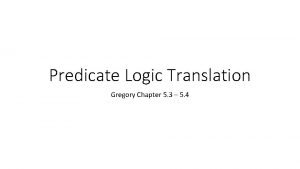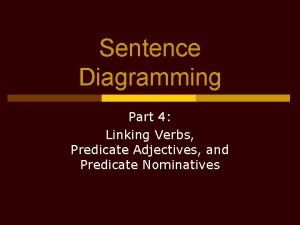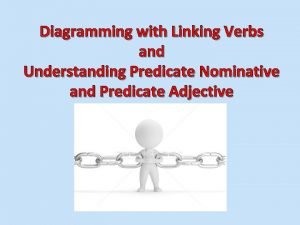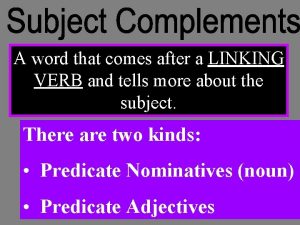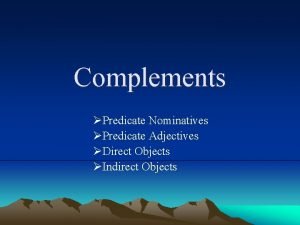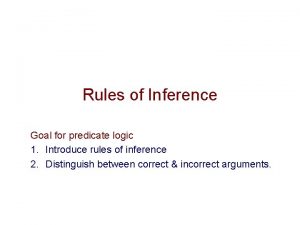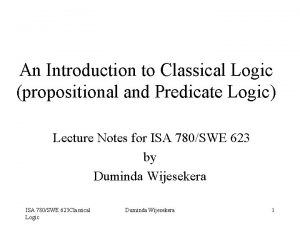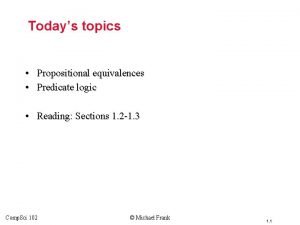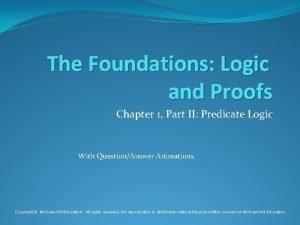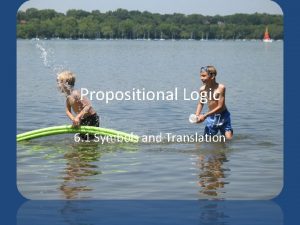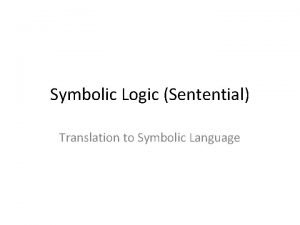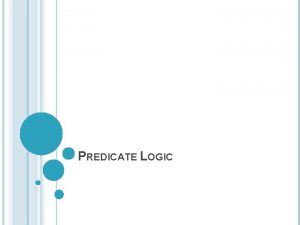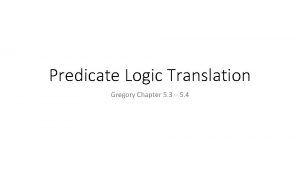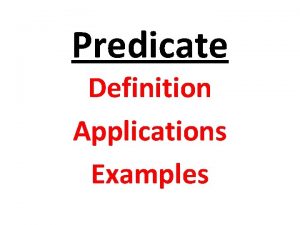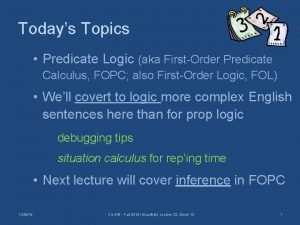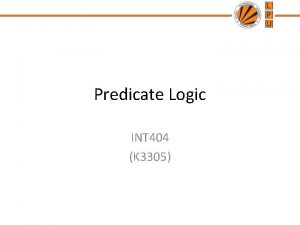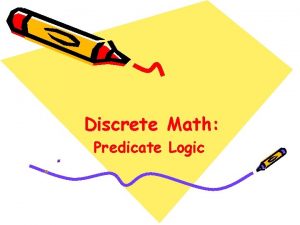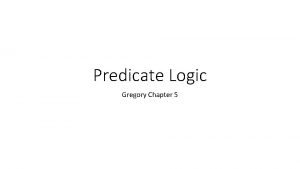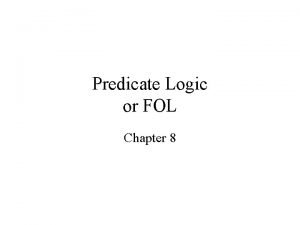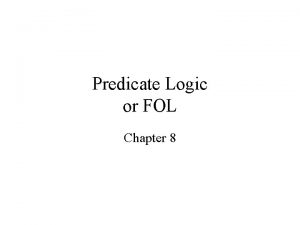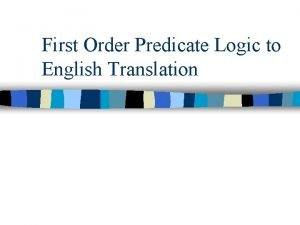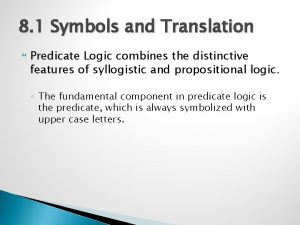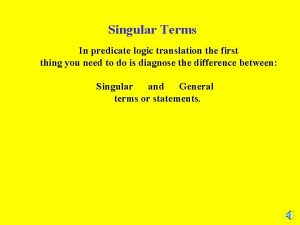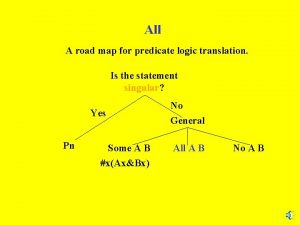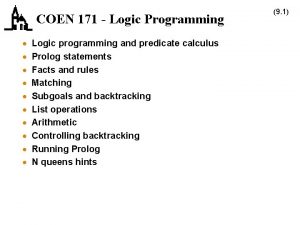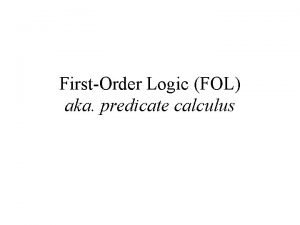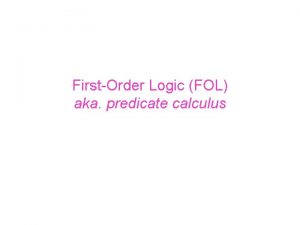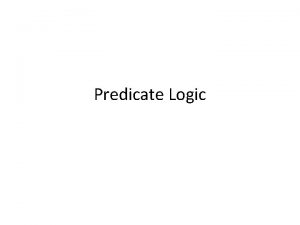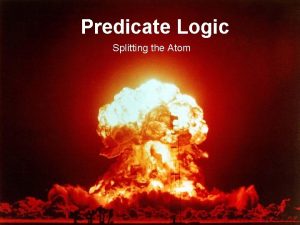Predicate Logic Translation Gregory Chapter 5 3 5






























- Slides: 30

Predicate Logic Translation Gregory Chapter 5. 3 – 5. 4

5. 3 Simple Symbolization

Satisfaction and Truth in P (Informal) It is important to have at least a rough understanding of quantificational semantics before proceeding to translate English into P. Consider the following rough definitions:

5. 3. 1 Non-Categorical Claims UD: {animals – human or other, real or mythological} Predicates: E: eats computer cables; D: is a dog; U: is a unicorn; O: is one-horned; H: __is the human of__ Individual Constants: a: Amalasuntha; b: Baber; c: Charlie. Dog • Singular Statements - Amalasuntha eats computer cables. - Baber does not eat computer cables. Ea ¬ Eb - Baber is Amalasuntha’s human. - Baber is not Charlie. Dog’s human Hba ¬ Hbc

5. 3. 1 Non-Categorical Claims UD: {animals – human or other, real or mythological} Predicates: E: eats computer cables; D: is a dog; U: is a unicorn; O: is one-horned; H: __is the human of__ Individual Constants: a: Amalasuntha; b: Baber; c: Charlie. Dog • Existence and Non-Existence - There are no unicorns. ¬ (∃x)Ux or (∀x) ¬ Ux ・ It is not the case that there exists an x such that x is a unicorn ・ For all x, x is not a unicorn. - There are dogs. (∃x)Dx or ¬ (∀x) ¬ Dx ・ There exists an x such that x is a dog. ・ It is not the case that all x are not dogs.

Quantifier-Negation (‘Push-Through’) Rules • Predicates: M: __is material; P: __is perfect - Nothing is perfect. ¬ (∃x)Px or (∀x) ¬ Px - Not everything is material. ¬ (∀x) Mx or (∃x) ¬ Mx • Note: the second two equivalence are unnecessary since we can push through the negation and then elimination double negation.

5. 3. 1 Aristotelian Categorical Propositions UD: {animals – human or other, real or mythological} Predicates: E: eats computer cables; D: is a dog; U: is a unicorn; O: is one-horned; H: __is the human of__ Individual Constants: a: Amalasuntha; b: Baber; c: Charlie. Dog • All unicorns are one-horned. (∀x)(Ux → Ox) • No dogs are one-horned. ¬ (∃x)(Dx ∧ Ox) • Some dogs eat computer cables. (∃x)(Dx ∧ Ex) • Some dogs don’t eat computer cables. (∃x)(Dx ∧ ¬ Ex)

Ex 5. 3. 2 Quantifiers and Connectives

Ex 5. 3. 2 Quantifiers and Connectives 1. Felix is grey and has whiskers 1. Gf ∧ Wf 2. If Felix is bigger than Sylvester, then Felix is a better 2. Bfs → Mfs mouser than Sylvester. 9. All cats either meow or have whiskers. 9. (∀x)(Mx ∨ Wx) 10. Either all cats meow or all cats have whiskers. 10. (∀x)Mx ∨ (∀x)Wx 17. Some cats like Felix, but not all do. 17. (∃x)Lxf ∧ ¬ (∀y)Lyf 18. Every cat likes itself. 18. (∀x)Lxx 19. If every cat likes itself, then there is a cat that likes 19. (∀x)Lxx → (∃x)Lxf Felix.

5. 4. 3 Categorical Claims • We’ll assume the ‘Modern’ Square of Opposition as above in translating categorical sentences. • Note: the most counterintuitive feature is that ‘All S are P’ doesn’t imply ‘Some S are P’ because we construe ‘All S are P’ as a conditional: for all x, IF x is S then it’s P, which doesn’t commit us to the existence of anything that’s S

Why? • Why do we do this? Why prefer translations according to the Modern Square of Opposition? • Because we want minimalist interpretations. If we want to say more we can add more. - ‘All S are P presupposes but does not assert that there are Ss so we can’t infer that some S are P. - ‘No S are P presupposes but does not assert that there are Ss so we cant infer that some S are not P. ・ No unicorns are vegetarians ・ We can’t infer that some unicorns are not vegetarians because there are no unicorns vegetarian or not: no unicorns are vegetarians because ther are no unicorns!

5. 3. 4 Exercises 1. Everyone is an accountant. (∀x) Ax 2. Everyone likes Kate. (∀x)Lxk 3. All the accountants are diligent. (∀x)(Ax → Dx) 4. No accountants are diligent. 5. Some accountants are not diligent. 30. If Fred works for Kate, then anyone who works for Fred works for Kate. 31. All and only those who work for Kate like her. 32. Everyone is s. t. that they like Kate if and only iff they work for her. ¬ (∃x)(Ax ∧ Dx), (∀x)(Ax → ¬ Dx) (∃x)(Ax ∧ ¬ Dx), ¬ (∀x)(Ax → Dx) Wfk → [(∀x)Wxf → Wxk] (∀x)[(Wxk → Lxk) ∧ (Lxk → Wxk)] (∀x)(Lxk ↔ Wxk)

5. 4 Complex Symbolizations Translation involving Overlapping Quantifiers

Overlapping Quantifiers • Somebody loves somebody. • Everybody loves everybody. (∃x)(∃y)Lxy (∀x)(∀y)Lxy • Everybody loves somebody or other. (∀x)(∃y)Lxy • There’s somebody who loves everybody. (∃x)(∀y)Lxy

Somebodies who love everybody

More Love…and Being Loved

Overlapping Quantifier Translation • Where both of the quantifiers are the same no problem. • If different, take care: - Everybody loves somebody (or other): (∀x)(∃y)Lxy We’re talking about everybody—saying that everyone of them is such that there’s someone or other they love. - Somebody loves everybody: (∃x)(∀y)Lxy We’re saying that there’s at least one individual, we don’t know who (but probably a dog), who loves everyone. • Be careful also about order: loving isn’t the same as being loved - Everybody loves somebody ≠ somebody loves everybody (∀x)(∃y)Lxy ≠ (∀x)(∃y)Lyx For all x there’s a y that x loves ≠ Everyone is such that there’s someone who loves them.

5. 4. 2 Exercises 1. Everyone likes everyone. (∀x)(∀y)Lxy 2. Someone likes someone. (∃x)(∃y)Lxy 3. Everyone likes someone. (∀x)(∃y)Lxy 4. Everyone is liked by someone. (∀x)(∃y)Lyx 5. Someone likes everyone. (∃x)(∀y)Lxy 6. Someone is liked by everyone. (∃x)(∀y)Lyx 7. Someone is liked by no one. (∃x)(∀y) ¬ Lyx 8. NOT there’s someone who likes no one. ¬ (∃x)(∀y) ¬ Lxy or (∀x)(∃y)Lxy 9. Somebody likes nobody. (∃x)(∀y) ¬ Lxy 10. Nobody likes everybody. ¬ (∃x)(∀y)Lxy

5. 4. 3 Identity • By identity we mean numerical identity—that what appear to be distinct objects are actually one and the same thing. Object x is identical to object y iff x is y. - Type/Token Ambiguity: distinguish identity from qualitative similarity - Counting by type and by token: individual inscriptions and ‘letters of the alphabet’: how many letters in ‘banana’? • Identity (‘=‘) as a special predicate - Syntactic convention: instead of ‘=xy’ we write ‘x = y’ - Identity is an equivalence relation ・ Reflexive: x = x ・ Symmetric: if x = y then y = x ・ Transitive: if x = y and y = z then x = z - Identity is an indiscernibility relation for all properties: if x = y then x is F if and only if y is F, for all properties F

Identity as the Counting Relation

5. 4. 4 Exercises 1. There at least two cashiers. 2. There at least two cashiers working for Kate. 3. There is exactly one cashier. 4. There is exactly one cashier working for Kate. 5. There is exactly one upbeat cashier working for Kate.

5. 4. 4 Exercises 6. There is exactly one upbeat cashier and he works for Kate. 7. There are exactly two accountants. 8. Exactly two accountants work for Kate. 9. Everyone but Fred works for Kate 10. The cashier is lazy.

Definite Descriptions • A definite description is an expression of the form ‘the so-and-so’ - e. g. ‘The US president’, ‘the tallest student in the class’, etc. • A definite description is is supposed to designate an object via a unique description of it—i. e. , a description that, if satisfied, is satisfied by one and only one object. • In natural language, definite descriptions behave like names, can be grammatical subjects of sentences to pick out objects and assign predicates to them. - The US president is a Republican. ・ Prima facie, selects an object in UD and says of it that it’s a Republican. - The present King of France is bald. ・ But France is a republic--there is no present King of France!

Definite Descriptions • A definite description is an expression of the form ‘The so-and-so’, e. g. ‘the cat on the mat’, ‘the 2020 Democratic presidential nominee’, ‘the present king of France’ • From the perspective of surface grammar these are referring expressions, which may figure as the subjects of sentences but… • What if nothing satisfies the description? What are we talking about? How can anything make sense if we aren’t talking about anything? • France is a republic: there is no present King of France!

Why Definite Descriptions are a Problem …or a present King of France!

Definite Descriptions • Solution: Russell’s Theory of Descriptions. • ‘Surface grammar’ is misleading: definite descriptions aren’t names. • Translate in terms of logical machinery: ‘The present King of France is bald’ is existential and general! And false!

Translations: Identity • There is at least one solution. (∃x)Sx • There are no unicorns. ¬ (∃x)Ux • There is more than one prime number. (∃x)Px ∧ (∃y)(Py ∧ y ≠ x) • The present King of France is bald (∃x)[Kx ∧ (∀y)(Ky → y =x ∧ Bx)]

Excluded Middle: P or not P • Consider the sentence P: ‘The present king of France is bald. ’ • P can’t be true since there is no present king of France. • Since it’s not true it must be false • Therefore we conclude that the present King of France is not bald, i. e. not P • But that’s also false since there is no present king of France • But this seems to violate Excluded Middle since we deny both P and not P

Russell’s solution • ‘The current King of France is bald says that: - (∃x)((Kx ∧ (Kx → (∀y)y = x)) ∧ Bx) • But this is false because the first conjunct it is: here is no current king of France; ‘Kx’ is just plain false. • So the whole thing is just plain false! • It is false (on this account) that the present King of France is bald! - or non-bald - or anything else! • Predicate logic gives us a way of translating that licenses inferences but we have to be careful!

The End
 Predicate logic translator
Predicate logic translator Diagramming subject complements
Diagramming subject complements Predicate noun examples
Predicate noun examples Sentence with predicate nominative
Sentence with predicate nominative Diagramming predicate adjectives
Diagramming predicate adjectives Predicate adjective and predicate nominative
Predicate adjective and predicate nominative Predicate nominatives and predicate adjectives
Predicate nominatives and predicate adjectives Examples of simple predicate
Examples of simple predicate Predicate logic rules of inference
Predicate logic rules of inference Implies in propositional logic
Implies in propositional logic Only one student failed in mathematics fol
Only one student failed in mathematics fol Predicate logic equivalence
Predicate logic equivalence The first order chapter 8
The first order chapter 8 The predicate for bob is freds father
The predicate for bob is freds father Predicate logic
Predicate logic First order logic vs propositional logic
First order logic vs propositional logic First order logic vs propositional logic
First order logic vs propositional logic Third order logic
Third order logic Concurrent vs sequential
Concurrent vs sequential Cryptarithmetic problem logic+logic=prolog
Cryptarithmetic problem logic+logic=prolog Software project wbs example
Software project wbs example Is it x y or y x
Is it x y or y x Combinational logic sequential logic 차이
Combinational logic sequential logic 차이 Logic chapter three
Logic chapter three Logic statements symbols
Logic statements symbols Symbolic logic translator
Symbolic logic translator Translate
Translate Cisco voice translation rule
Cisco voice translation rule Transformation of a function
Transformation of a function Semantic translation và communicative translation
Semantic translation và communicative translation Greg kesden
Greg kesden
